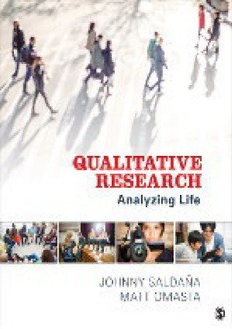
Qualitative Research: Analyzing Life PDF
Preview Qualitative Research: Analyzing Life
Qualitative Research 2 3 Qualitative Research Analyzing Life Johnny Saldaña Arizona State University Matt Omasta Utah State University 4 FOR INFORMATION: SAGE Publications, Inc. 2455 Teller Road Thousand Oaks, California 91320 E-mail: [email protected] SAGE Publications Ltd. 1 Oliver’s Yard 55 City Road London, EC1Y 1SP United Kingdom SAGE Publications India Pvt. Ltd. B 1/I 1 Mohan Cooperative Industrial Area Mathura Road, New Delhi 110 044 India SAGE Publications Asia-Pacific Pte. Ltd. 3 Church Street #10-04 Samsung Hub Singapore 049483 Copyright © 2018 by SAGE Publications, Inc. All rights reserved. No part of this book may be reproduced or utilized in any form or by any means, electronic or mechanical, including photocopying, recording, or by any information storage and retrieval system, without permission in writing from the publisher. Brief quote on page xxi is from p. 206 from the Search for Signs of Intelligent Life in the Universe by JANE WAGNER. Copyright (©) 1986, 1990 by Jane Wagner Inc. Reprinted by permission of HarperCollins Publishers. Printed in the United States of America Library of Congress Cataloging-in-Publication Data Names: Saldaña, Johnny, author. | Omasta, Matt, 1980- author. Title: Qualitative research: analyzing life/Johnny Saldaña, Arizona State University, Matt Omasta, Utah State University. Description: First Edition. | Thousand Oaks : SAGE Publications, Inc., 2017. | Includes bibliographical references. Identifiers: LCCN 2016037493 | ISBN 9781506305493 (pbk.: alk. paper) Subjects: LCSH: Social sciences—Research—Study and teaching (Higher). Classification: LCC H62.S31865 2016 | DDC 001.4/2—dc23 LC record available at https://lccn.loc.gov/2016037493 This book is printed on acid-free paper. 5 Acquisitions Editor: Helen Salmon Editorial Assistant: Chelsea Pearson eLearning Editor: Katie Ancheta Production Editor: Kelly DeRosa Copy Editor: Alison Hope Typesetter: C&M Digitals (P) Ltd Proofreader: Susan Schon Indexer: Joan Shapiro Cover Designer: Gail Buschman Marketing Manager: Susannah Goldes 6 Brief Contents 1. List of Displays 2. Preface 3. Acknowledgments 4. About the Authors 5. Part I— Analyzing Qualitative Data 1. Chapter 1— Introduction: Analyzing Life 2. Chapter 2— Analyzing Field Sites 3. Chapter 3— Analyzing Documents, Artifacts, and Visual Materials 4. Chapter 4— Analyzing Interviews: Preparing, Conducting, and Transcribing 5. Chapter 5— Analyzing Interviews: Condensing and Coding 6. Part II— Analyzing the Framework 1. Chapter 6— Analyzing Qualitative Methodologies 2. Chapter 7— Analyzing Qualitative Research Design 3. Chapter 8— Analyzing Research Ethics 7. Part III— Analytic Assemblage 1. Chapter 9— Analytic Synthesis: Condensing, Patterning, and Unifying 2. Chapter 10— Analytic Synthesis: Understanding, Interpreting, and Theorizing 3. Chapter 11— Analytic Write-Ups 4. Chapter 12— Analytic Presentations 5. Chapter 13— Closure: Leading an Analytic Life 8. Appendix—Three Representative Articles in Qualitative Research 9. Glossary 10. References 11. Index 7 Detailed Contents List of Displays Preface The Organization and Through-Line of the Book The Coauthors’ Approach To the Instructor Acknowledgments About the Authors Part I— Analyzing Qualitative Data Chapter 1— Introduction: Analyzing Life Learning Objectives Introduction Developing Fundamental Qualitative Analytic Skills Condensing large amounts of data Noticing patterns in textual and visual materials Unifying seemingly different things Understanding social processes of human action, reaction, and interaction Interpreting the routines, rituals, rules, roles, and relationships of social life On Qualitative Data Analysis—and Life Closure and Transition Resources for an Introduction to Qualitative Analysis Analytic Exercises Sample Data for Analysis Chapter 2— Analyzing Field Sites Learning Objectives Introduction On Culture Observation Settings Finding a place and space Access The Observer’s Frames Lenses, filters, and angles for fieldwork Observer membership roles Purpose-driven observations Field Notes Written documentation of analytic observations Front matter The setting 8 Jottings and write-ups Observer’s comments Time stamps Technical Matters of Fieldwork and Field Notes Audio- and video-recording Fieldwork clock hours Field note files Analyzing Observations of Social Life Reflecting on action, reaction, and interaction Reflecting on routines, rituals, and rules Reflecting on roles and relationships Analytic memoing of field notes Closure and Transition Resources for Participant Observation Analytic Exercises for Participant Observation Sample Field Notes for Analysis Chapter 3— Analyzing Documents, Artifacts, and Visual Materials Learning Objectives Introduction On Values, Attitudes, and Beliefs Analyzing Manifest and Latent Contents The Materials and Meanings of Human Production Analyzing Documents Collecting materials Analyzing attention Analyzing identity Analyzing Artifacts Analyzing belonging Analyzing symbolism Analyzing process Analyzing extensions Analyzing Visual Materials Analyzing collaboratively Analyzing evocation The Routines, Rituals, Rules, Roles, and Relationships in Documents, Artifacts, and Visual Materials Closure and Transition Resources for Analyzing Documents, Artifacts, and Visual Materials Analytic Exercises for Documents, Artifacts, and Visual Materials Sample Photograph 9 Chapter 4— Analyzing Interviews: Preparing, Conducting, and Transcribing Learning Objectives Introduction Types of Interviews Surveys and structured interviews Semi-structured interviews Unstructured interviews Focus groups Participant Selection Sampling methods Number of interviews Interview Preparation, Scheduling, and Arrangements Audio- and video-recording equipment Asking Questions Interview protocols Phrasing the inquiry Maintaining the conversation Transcribing Basic documentation principles Topic summaries Closure and Transition Analytic Exercises for Interviewing Chapter 5— Analyzing Interviews: Condensing and Coding Learning Objectives Introduction Interview Condensation Analyzing Interviews Through Codes and Coding In vivo coding and analytic formatting Process coding Values coding Emotion coding Closure and Transition Resources for Interviewing Analytic Exercises for Interviewing Sample Interview Transcript Part II— Analyzing the Framework Chapter 6— Analyzing Qualitative Methodologies Learning Objectives Introduction Theoretical Premises of Qualitative Research 10
